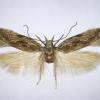35.019 Anarsia lineatella Zeller, 1839
Status and Distribution
See also Anarsia innnoxiella.
A. lineatella Zeller, 1839 was first found in the British Isles as a larval adventive in imported fruit in 1957 and has continued as such on an occasional basis since then. Adults have been recorded at MV light on a few occasions (in Cardif at an urban site with warehouses and adjacent shops in 1997, Dorset in 2003 and Regents Park, London in 2019) although the Cardiff and London moths are most likely a result of larvae in imported fruit. The Dorset record may involve a genuine migrant but this is purely speculative.
Until 2017 Anarsia lineatella (sensu lato) was considered to have established itself as a very local resident in parts of southern and south-east England. However, following the publication of A. innoxiella as a new species in 2017, checks carried out by County Moth Recorders and others discovered that all but a very few records of supposed adult A. lineatella (where specimens or good photos have been made available for examination) were referable to Anarsia innoxiella.
With the exception of the A. lineatella (sensu stricto) adults mentioned above, all other records relate to locations where the larva has been found in imported fruit. There are two records from the Channel Islands, one of which relates to a larva; it is unknown if the other relates to a moth or a larva.
Provisional map
Foodplant and Larval Feeding Signs
Larva have been found on, and bred from a range of imported fruit including Prunus armeniaca (apricot), P. persica (peach), P. persica var. nectarina (nectarine), Prunus sp. (cherries of French origin) and Spondias sp. (spanish plum). Perhaps unsurprisingly, in view of the recent discovery that most wild caught A. lineatella in Britain are actually referable to A. innoxiella (which feeds on Acer spp.), the larva of lineatella has not been found in the wild in the British Isles or Channel Islands.
An additional foodplant in Europe is Prunus dulcis (almond).
Habitat
First recorded and bred from a larva found feeding inside an imported peach on 8th August 1957. It now seems unlikely that this species has bred in the wild in Britain.
Finding the Moth
Larva: frass and fruit damage have been found around the stalk base on imported apricot, nectarine, peach and plum. In France the larva has been found in the spring feeding inside a peach flower-bud expelling dry reddish frass through a hole.
Adult: an adventive, bred from imported fruit. A single record of an adult at light might indicate it is also a rare migrant into Britain but an adventive origin of this wild-caught moth cannot be excluded.
Similar Species
In 2017 Anarsia llneatella was found to comprise two separate species, A lineatella and A. innoxiella. The former has a more uniform and overall darker coloured forewing which is more black and white in A. innoxiella. The longitudinal black spot in A. lineatella is usually followed by a whitish area in the middle of the forewing, an area that has a straight elongate black streak in A. innoxiella.
A fine-streaked form of Anarsia spartiella might be confused wiith some less well marked or worn A. lineatella or A. innoxiella with short fine black lines. This is particularly the case if the moth has an indistinct costal blotch at one half which may be confused with the angled dark-grey to blackish subquadrate costal mark present in A. lineatella.
The large and dense tuft of projecting scales present on segment two of the palps in Anarsia sp. are present to a much lesser extent in Gelechia senticetella (which is slightly smaller and brownish-grey but can be quite heavily streaked with black) and G. sabinellus.
As an Adventive species which has been bred from larvae on imported fruit it is not known in the wild other than from a single adult attracted to light in Dorset on 15th July 2003. The origin of this moth is unknown.








